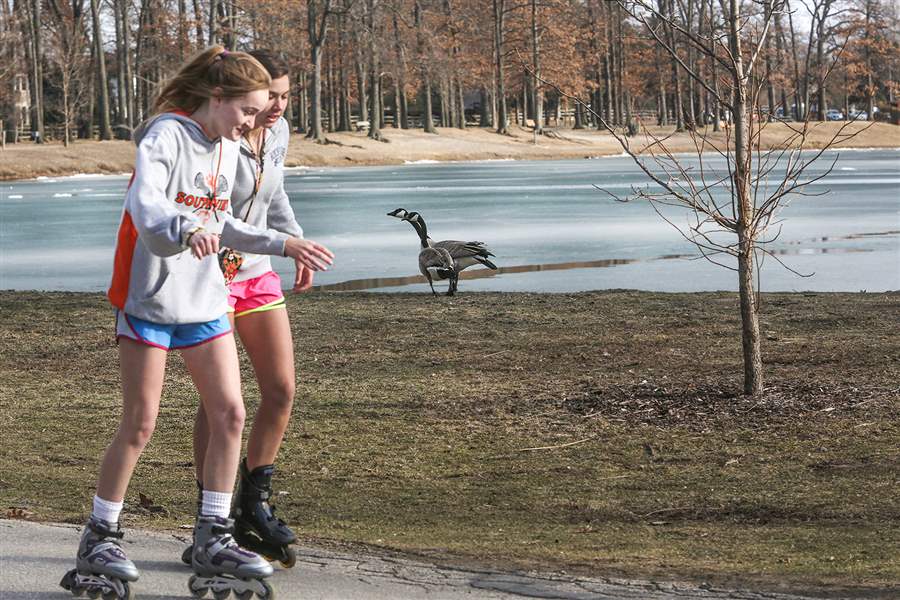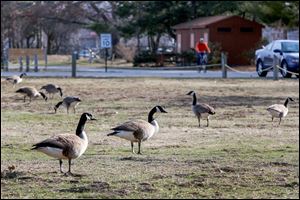
Sylvania park to curb goose population
Visitors have complained of growing nuisance
4/7/2014
Jaquelyn Adamson, 16, left, and Meghan Mitchell, 16, both of Sylvania, rollerblade past Canada geese at Olander Park in Sylvania. Visitors to the park have complained about goose feces at the park.
THE BLADE/KATIE RAUSCH
Buy This Image

Jaquelyn Adamson, 16, left, and Meghan Mitchell, 16, both of Sylvania, rollerblade past Canada geese at Olander Park in Sylvania. Visitors to the park have complained about goose feces at the park.
The Ohio Department of Natural Resources Division of Wildlife has granted a permit to the Olander Park System in Sylvania to allow it to addle eggs of Canada geese in nests in an effort to curb the growing goose population.
Interim Park Director Erika Buri said the permit was issued on Wednesday with an Aug. 31 expiration date. It provides guidelines and specifications. The park system applied for the permit as an option to control the Canada goose population at Olander Park, which has a one-mile walkway and a lake used by residents for swimming.
Lately park-goers have complained about the nuisance of the geese, about obtrusive goose droppings on the path, and about feces in the lake, calling it is a sanitary issue, park officials said. Officials said geese have been aggressive toward park visitors if they get near a nest.
“If this doesn’t work then we will look for other cost-effective options,” Ms. Buri said. The removal of eggs is cost free, she said. One option discussed at a park commissioners’ meetings, but tabled, was allowing dogs in the park to deter geese. Olander is a dog-free park.
“Since we never had dogs there, we didn’t want to get into the enforcement of who could bring a dog in,” Commissioner John Zeitler said. “Our trails are not very wide.” Other parks in the system allow leashed dogs. Officials were also concerned that dogs would create another feces problem.

The Ohio Department of Natural Resources has given the Olander Park System a permit to remove eggs, destroy the yolk, and return the eggs to satisfy the ‘nesting instinct’ of Canada geese.
Ms. Buri said tall grasses will be planted in the spring around the lake’s edge, which also deters the birds from entering the lake and will assist with land erosion. However, the process could take about a year to grow in. Cost for that project has yet to be estimated.
The egg removal permit specifies explicit guidelines on how the egg yolk is essentially destroyed by shaking it while keeping the whole egg intact as a means to “satisfying its (Canada goose’s) nesting instinct.” The park must return the eggs back to the nest, the permit says. If not the goose will simply build another nest and lay more eggs to satisfy its instinct.
In Ohio, generally geese begin incubating eggs between mid-March and early-May, with a peak in April.
The eggs may also be oiled. The oil clogs the pores on the shell, and the embryo dies from asphyxiation.
The park conducted an egg removal in 2011, “and while that was pretty effective, we didn’t get all the eggs,” Ms. Buri said. She said it did result in a decrease in the goose population that year.